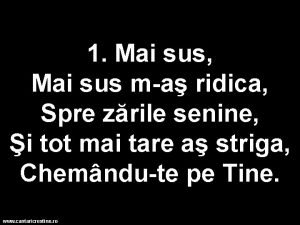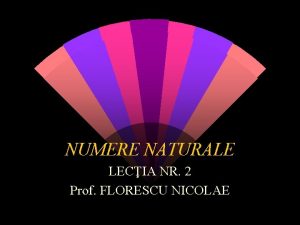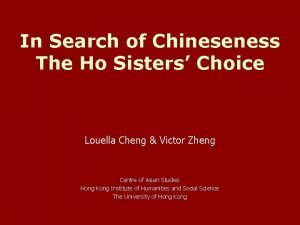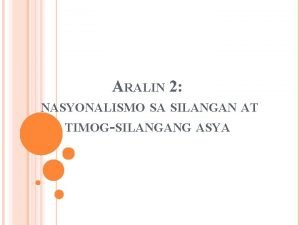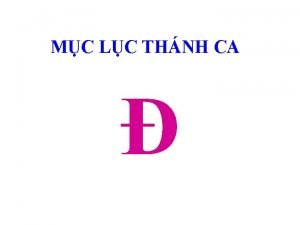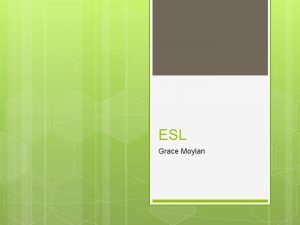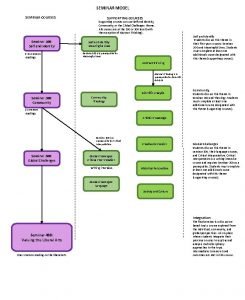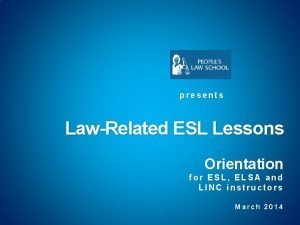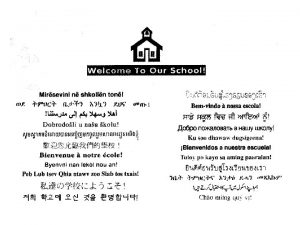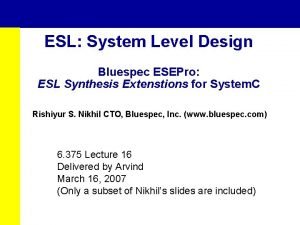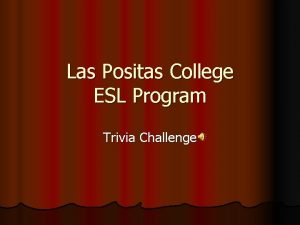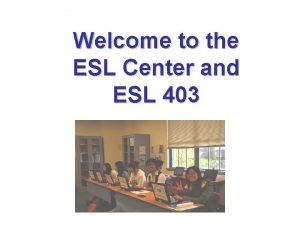TER ESL Courses Dr Fawzia Mai Tung Why














- Slides: 14

TER ESL Courses Dr. Fawzia Mai Tung

Why a different course? �All Foreign Language courses have only ONE curriculum/syllabus. �Either based on how to read/write �Takes too long until can speak �Speaks very slowly, with heavy accent �Or on spoken/useful phrases �Very difficult to learn effective reading/writing �Solution: �Combine TWO separate syllabi into ONE course.

Components of the course �Listening and Speaking �Pimsleur Method �Reading and Writing �Spalding Method �Culture: �TER materials

Course Design �Each course lasts 5 weeks. �Each week: two classes �Each class: 1. 5 hours � 30 minutes: listening and speaking � 30 minutes: reading and writing � 30 minutes: culture �Courses are designated: �ESL 1, ESL 2, ESL 3, ESL 4, ESL 5 �After ESL 5, most students are able to move to any other course or school work with no problems.

What is the Pimsleur Method? �Developed by Dr. Paul Pimsleur, a professor of French, education and romance languages, as well as one of the founders of ACTFL. �Widely recognized in the field of research in language acquisition.

Characteristics of the Pimsleur Method �Audio-based language acquisition �Stresses participation over rote memorization �During lessons, the listener repeats words and phrases given by native speakers and constructs new phrases by inference. As new phrases are introduced, the listener is prompted to recall older phrases. The prompts for any given phrase are gradually spaced out in ever-increasing intervals.

Characteristics of the Pimsleur Method (cont’d) �Focuses on proficiency in speaking � 30 -minute lessons �Repeat until reach 80% comprehension �Students listen to BOTH native and target languages �Responses are: �A) repeated �B) formed by student �Graduated intervals �Teaches blocks of words (functional units)

Four Principles � 1: � 2: � 3: � 4: Anticipation Graduated interval recall Core vocabulary Organic Learning

Use of Pimsleur in this course �Units 1 -8 in ESL 1 � 8 units per course (40 total) �Be Flexible ! �For languages not offered by Pimsleur, you must become familiar with the material by listening to the recordings for another language. �Then use the transcripts �Important: respect the time intervals!!!

What is the Spalding Method? �See separate presentation

What are the culture materials? �Mostly power points developed by Tung Education Resources �Include: �History �Geography �Culture �Literature

What are the Vocabulary ppts? �Expand oral vocabulary �Based on core vocabulary from Pimsleur units �Only listening recognition required �Use as listed

How to use the culture & vocabulary ppts �One per class at first � 6 for course ESL 1 �Thereafter: �Be flexible �Can be skipped if Reading and Writing take too much time �Topic that pops up in the Reading material may be used for further cultural discussions

Thank You!
 Fawzia rashid
Fawzia rashid Quem encontrou um amigo encontrou um tesouro bíblia
Quem encontrou um amigo encontrou um tesouro bíblia Mai sus mai sus m-as ridica
Mai sus mai sus m-as ridica Sirul numerelor naturale
Sirul numerelor naturale Reo
Reo Hey bye bye
Hey bye bye Don't ask why why why
Don't ask why why why Tcm hospital malaysia
Tcm hospital malaysia Cùng nhau tung hô danh chúa
Cùng nhau tung hô danh chúa Florence yeo
Florence yeo Nasyonalismo ng silangang asya
Nasyonalismo ng silangang asya Này từng giọt rượu nho
Này từng giọt rượu nho đau thương tiêu mất nơi gô gô tha
đau thương tiêu mất nơi gô gô tha Dr nathalie leung
Dr nathalie leung Aset alokasi tung desem waringin
Aset alokasi tung desem waringin


